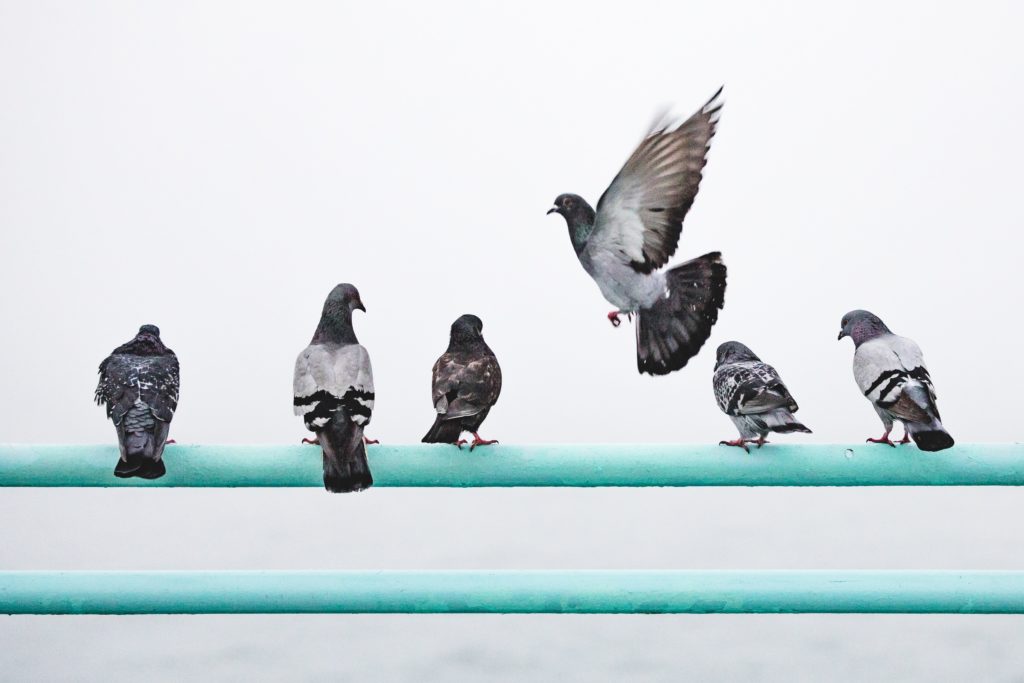
Feral Rock Pigeons gather at the Manhattan Beach Pier, in Manhattan Beach. Photo by Nathan Dumlao on Unsplash
Introduction
This Resource Is Not Meant To Be A Comprehensive Treatment Of Pigeon Care!
In this resource, we wish to provide caregivers with a general introduction to how pigeons have come to need the care and attention of rescuers and farmed animal sanctuariesAnimal sanctuaries that primarily care for rescued animals that were farmed by humans., as well as some background on their history, social lives, and behaviors in the wild to help assist caregivers with some basic necessary considerations in considering whether they should, and if so, how they should care for pigeons.
Human associations around pigeons could be described as paradoxical, and as a result, pigeons may not be the first species that you think of when it comes to sanctuary. This may be because these birds, due to no fault of their own, suffer from significant stigma. Yet pigeons are also the subject of multiple forms of unfortunate human use and exploitationExploitation is characterized by the abuse of a position of physical, psychological, emotional, social, or economic vulnerability to obtain agreement from someone (e.g., humans and nonhuman animals) or something (e.g, land and water) that is unable to reasonably refuse an offer or demand. It is also characterized by excessive self gain at the expense of something or someone else’s labor, well-being, and/or existence.. The domestication and use of pigeons by humans date back to around 3000 BCE, from the fifth Egyptian dynasty. Their use as a “messenger system” dates back to 1150 CE, and pigeons continued to be used as emergency message carriers in wars between humans well into the 20th century. Some individual pigeons have been “celebrated as war heroes” after being used in this context, but there is a much more overwhelming tendency among humans to stigmatize and denigrate these birds, even as humans continue to use and exploit them for their flesh, their eggs, for target practice, and for entertainment.
Stigma is rooted in misinformation, and there are a lot of misconceptions out there about pigeons. First of all, let’s consider the language used around these birds, which often involves arbitrary and pejorative word use that ignores basic taxonomy and is often used to denounce some individuals while elevating others. Consider, for example, that while “doves” are typically vaunted as symbols of peace and love, you may have heard pigeons conversely referred to as “flying rats” or “invasive.”
Please Be Mindful Of Speciesist Language Around Rats And Pigeons!
Both rats and pigeons are stigmatized by many humans as being unclean, along with other misperceptions. Therefore, humans are generally counseled to avoid and destroy them when possible. While, as in any context dealing with a loose or stray animal, rescuers must take safety and health precautions, the truth is that both rats and pigeons are meticulous regarding their grooming and cleaning. While they, like any animal, can potentially harbor external parasites or suffer an illness, they are not fundamentally “toxic” to humans. Part of combating speciesismA form of discrimination based on species membership; the belief that different species of animals deserve different ethical considerations regardless of whether they have similar needs or interests. involves countering stereotypes like these and standing up for beings like pigeons and rats. Neither species deserves the negative connotations associated with them, and they, like all animals, deserve advocates with the knowledge to stand for them and support them.
Did you know that pigeons and doves are, in fact, all members of the same family, the Columbidae family? How the terms “dove” and “pigeon” are used are strictly colloquial and have nothing to do with scientific nomenclature but, in fact, as mentioned above, are often used with no basis to justify harmThe infliction of mental, emotional, and/or physical pain, suffering, or loss. Harm can occur intentionally or unintentionally and directly or indirectly. Someone can intentionally cause direct harm (e.g., punitively cutting a sheep's skin while shearing them) or unintentionally cause direct harm (e.g., your hand slips while shearing a sheep, causing an accidental wound on their skin). Likewise, someone can intentionally cause indirect harm (e.g., selling socks made from a sanctuary resident's wool and encouraging folks who purchase them to buy more products made from the wool of farmed sheep) or unintentionally cause indirect harm (e.g., selling socks made from a sanctuary resident's wool, which inadvertently perpetuates the idea that it is ok to commodify sheep for their wool). to some while celebrating others. We at the Open Sanctuary Project believe that language choices are important and that we must choose our language in a way to accord compassion to those who deserve it. As a result, for this resource, we have chosen to refer to all members of the Columbidae family as pigeons, as we believe that the term should be destigmatized and that all members of this family are equally worthy of respect and kindness.
General Characteristics Of Pigeons: Background For Caregivers
The Columbidae family consists of approximately 308 different species of birds, which are distributed worldwide and in all kinds of terrestrial habitats, with the only exception being Antarctica. Generally, the family is divided into fruit-eating and seed-eating species. While all of these species have a common appearance of stockiness, short legs, short beaks, and short legs, plumage colors can vary widely and can be quite spectacular, particularly in some of the fruit-eating pigeon species.
Regarding lifespan, while feral or wild pigeons typically live between three and six years (which can vary depending on their environment), pigeons kept in captivity have been documented to live twenty years or more. This is an important consideration for anyone considering taking in pigeons as residents, as you will want to consider this long lifespan when it comes to assessing the lifelong costs of compassionate care for your pigeon residents, as well as your sanctuary, rescue, or animal organization’s capacity to responsibly take in new residents.
Keep In Mind Legal Restrictions Around Pigeons!
Sadly, like roosters, for example, pigeons suffer from significant unwarranted stigma, and as a result, there may be restrictions and rules around feeding, keeping, or caregiving for them. Before you embark on pigeon rescue and sanctuary, make sure you check into your local ordinances and rules around the keeping and care of members of the pigeon family.
Pigeon Behavior
In terms of behavior, pigeons are monogamous, which may be why certain species of pigeons have been celebrated as “a symbol of love.” Male pigeons engage in impressive displays to woo females. While these displays may vary among the many diverse species in this family, typically, it involves males dancing on the ground for the female, engaging in calls, or sometimes even aerial displays.
Pigeons can breed year-round or annually, and some of their mating behavior may be dependent on the availability of resources. This is an important element of pigeon behavior for sanctuaries who care for pigeons to keep in mind. Pigeons kept in safety with abundant food may attempt to raise offspring year-round, which requires special attention from caregivers, who must monitor the nests of pigeon couples for eggs, remove them promptly, and substitute them with “fake eggs” to avoid inadvertent breeding. Remember, because of the overwhelming need for so many animals to find sanctuary, sanctuaries mustn’t allow residents to breed, either purposefully or accidentally. Giving pigeons fake eggs can help prevent females from excessive laying, which can deplete their calcium reserves and cause them harm. Simply removing eggs may prompt a determined pigeon to lay even more eggs! However, taking eggs and substituting them with fake ones allows pigeons to indulge in nesting behaviors while preventing new offspring.
Socially, while pigeons can vary across species, with some preferring a solitary existence, most pigeons you will likely encounter are going to be happier in a bonded pair or a flock situation. They can exist in flocks of thousands and generally demonstrate hierarchical behaviors within those flocks, as do birds such as chickens. Also similar to chickens, pigeons are prey animals and, as such, require safe predator-proof housing and aviaries which can protect them from the multiple kinds of predators that can potentially cause them grievous harm or death. In fact, pigeons’ short incubation periods, frequent breeding, and flocking behaviors are a direct evolutionary response to the threats that they face from predation.
In another similar manner to chickens, pigeons are underestimated regarding their cognitive and other abilities. For example, like chickens, pigeons have a refined sense of magnetoreception. This means that they can use two types of information from the Earth’s geomagnetic field for navigation. First, they can sense this information visually, and second, through iron-containing sensory dendrites in their beak areas. Magnetoreception allows pigeons to perceive direction, altitude, and location, as well as allowing them to develop regional maps. Sadly, pigeons’ special skills in this area have led to one unfortunate form of exploitation, pigeon racing, which will be discussed further below.
All Creatures, Regardless Of Their “Intelligence,” Are Worthy Of Protection
While we have discussed pigeons’ special abilities and generally social and amiable nature, we also need to emphasize that an individual’s right to be spared from exploitation shouldn’t be related to their intelligence, their relationality to humans, or their cognitive abilities, or their appearance. All sentient individuals are deserving of consideration and freedom from unnecessary suffering and direct or indirect harm from humans. We discuss different “types” of pigeons in this resource solely from the lens of providing greater understanding regarding rescue needs and compassionate caregiving for specific individuals.
When it comes to pigeon vocalizations, most people think of cooing, but pigeons can emit many other noises, including wing claps and wing whistles, grunts, and hissing, generally meant to alert other members of their flock to threats nearby. Despite this, pigeons are largely very docile, peaceful, and quiet birds. As a function of this, pigeons actually are a very good species candidate for those who are interested in exploring creating a microsanctuaryA microsanctuary is a small scale community of human and nonhuman (generally “unconventional or farmed”) animal companions, who live together in a chosen shared lifestyle and in commitment to ending the oppression of all beings. Microsanctuaries adhere to the notion that no nonhuman member of the community should “serve a purpose.” Microsanctuaries can exist in any context: rural, suburban, or urban. A microsanctuary can consist of as small a community as one animal and one human caregiver. For more information on microsanctuary please refer to the Microsanctuary Resource Center., and particularly an urban microsanctuary in their future!
Pigeon Types Your Sanctuary or Rescue May Encounter And How You Can Help Them
Before Embarking on Pigeon Rescue, Consult Experts!
Because pigeon rescue can involve complex questions around who needs veterinary intervention, who can be released back to their flocks after simple interventions like destringing, and what kinds of pigeons are particularly vulnerable, you should connect with rescuers who are skilled with pigeons in advance of deciding whether to work with these birds. In particular, it is very helpful to identify veterinarians who are willing to work with pigeons as well as rehabbers who are willing to help them. Because pigeons are considered to be “invasive,” this may limit which rehabbers, rescues, shelters, and veterinarians are willing to work with them. Having these resources identified and lined up before deciding to work with pigeons is a critical step in providing them with quality compassionate care.
Given the wide diversity of the Columbidae family, if your sanctuary, rescue, or animal organization chooses to care for pigeons, there are many kinds that you may encounter. While we cannot cover all the species of pigeons you may encounter in this resource, there are three common “types” (which may encompass multiple species) that you will see most frequently. We will address these three common “types” here:
Rock Pigeons
Rock pigeons are probably what most people envision when they think of pigeons. As a result of human activities, rock pigeons have expanded their ranges and population sizes and are the most common pigeon species that you will encounter in, for example, an urban setting. Rock pigeons were originally native in a range from Europe to North Africa and India, but they have been carried across the world for human use in different ways and are now a common sight in most urban landscapes.
Rock pigeons range in coloration from blue to grey and often have barred markings on their wings and iridescent coloring on their cropA crop is a pouched enlargement of the esophagus of many birds that serves as a receptacle for food and for its preliminary maceration. and neck areas. They are often found roosting on buildings in urban centers and foraging for food (as well as entreating public humans for food). You may see variations in coloration when it comes to feral pigeons. This can be a function of cross-breeding with other breeds of pigeons who were accidentally or intentionally released by humans. Please note that fully white birds are not likely rock pigeons and may require special care and fast rescue. This will be discussed further below.

As with many birds who have been “domesticated” by humans and became feral, rock pigeons are hardy and have adapted in their own innovative and creative ways to new settings, which is why some people may label these birds as “invasive.” Reframing this narrative is critical. Understanding and explaining to others that rock pigeons actually got here as a function of human interference in their lives is a good step forward to understanding and dismantling the stigma around these birds. Rock pigeons have been exploited by humans for food, for their eggs, have been trained for “homing” in the context of carrying messages in human wars, and also selectively bred for “racing” for human entertainment and gambling. They have been subjected to exploitative and invasive research as well. These birds deserve a more compassionate understanding and more empathetic narrative than being simply labeled as “invasive flying rats,” especially since the situations that humans have placed them in have often put them in the face of risks they would not have faced in their native habitat.
Because they are considered by many to be “invasive” or “nuisances,” municipalities often openly embrace non-compassionate “pigeon control methods” that range from poisoning them to actively engaging humans to shoot these birds when they roost at night, even in populated urban settings. Sometimes municipalities engage pigeon trappers to capture birds en masse and transfer them out of cities, to be used as targets for shooting practice by sport shooters. Furthermore, because of how pigeons live and construct their nests, they have become subject to even more risks related to humans.
Stringfoot
Consider the risk of “stringfoot.” This is one of the most common conditions that urban feral pigeons may suffer. When pigeons pair off and begin to breed, they construct a nest together that typically consists of twigs or stems, usually brought by the male to the female. The nest is typically built in a higher area – in urban settings, these may be building ledges or trees or in niches they may find in underpasses or under bridges. But typical pigeon nest building material is scarce in urban settings. As a result, pigeons often creatively use what they find, which can mean they use materials like wires, strings, and even sometimes human hair!
These materials often create a serious risk for urban pigeons, who spend substantial amounts of time in their nests. Their feet can become entangled in these kinds of materials, which can cause lesions and a loss of circulation, infection of open wound sites, as well as necrosisNecrosis is the death of most or all of the cells in an organ or tissue due to disease, injury, or failure of the blood supply. and loss of limbs. Even with such injuries, pigeons are resilient and can still thrive with missing toes in the wild. Helping to “detangle” the feet of stringfoot pigeons is one way that you and your animal organization can support these birds. Because pigeons are often eager to receive food and treats from kind humans, you can lure flocks of pigeons to you by offering them pigeon-appropriate seeds and net individuals you see with stringfoot. If you can detangle their feet and get them appropriate veterinary care if necessary, you can help relieve a pigeon from a painful and dangerous condition. Even with missing toes, urban pigeons may be able to rejoin their flock after treatment, who tend to gravitate around and protect particular nesting areas.
Check In With Your Vet!
As noted above, having the insight of experienced pigeon rescuers, and particularly the insight of skilled veterinarians, is crucial to ensuring that pigeons you encounter receive the best care possible. Particularly when it comes to decisions around releasing recovered pigeons, you should speak to and consult with your vets and experienced rescues. While reuniting treated birds with their flocks is a good goal, especially because pigeon families bond so deeply, in some cases, this may be a tough decision based on the state of health of the pigeon involved. Every bird is an individual, and having veterinary insight will be a critical help in making these kinds of decisions.
In the picture with two humans above, pigeon rescuers evaluate a pigeon after capture before “destringing” their feet. These rescuers were able to lure a pigeon flock with pigeon-appropriate seeds and treats and quickly net those in need of assistance. Photo courtesy of Lucy Milling.
The picture showing a pigeon held in the hands of a human above shows a feral rock pigeon captured during a rescuer “destringing missionThe stated goals and activities of an organization. An animal sanctuary’s mission is commonly focused on objectives such as animal rescue and public advocacy..” This pigeon was caught and destrung before they suffered debilitating damage to their feet from the hair entwined around them. They were able to be immediately released to their flock after destringing. Photo courtesy of Christine Fox.
The picture showing the lower half of a pigeon shows permanent damage to their feet after recovering from stringfoot injuries. They were captured during a pigeon rescuer “destringing” mission. Unfortunately, stringfoot claimed many of their toes. They were brought to a veterinarian and received an assessment and care and were ultimately kept by adopters. Photo courtesy of Lucy Milling.
Racing Pigeons
Unfortunately, pigeons have long been exploited for human entertainment and gambling activities. This practice has an ancient underlying history. Remember how we discussed pigeons’ ability with magnetoreception above? Rock pigeons, as well as other species of pigeons, have been selectively bred for their “homing” abilities, as well as for physical characteristics that favor their ability to fly for long distances.
Pigeon racing consists of birds who are taken from their homes and families and released hundreds of miles away. The birds that return fastest are “winners.” This practice is fueled by human gambling, and the amount of money involved can be staggering. As a result, “racing hobbyists” selectively breed, sell, and purchase birds for large sums of money to secure “winners.” What falls by the wayside are the many birds who either die en route in their attempts to return “home”, or individuals who are injured or get lost and forever are separated from their families.
A racing pigeon who fails to find their way home will often attempt to join a feral pigeon flock. However, they may or may not be accepted. While many of them may closely resemble feral rock pigeons with similar coloration and markings, some of them are white, and these individuals are especially at risk from predation. You can typically identify a survivor of pigeon racing from a feral flock by the telltale leg bands that they often wear.
In general, it is safe to assume that banded pigeons have been raised in captivity by humans. They are therefore generally not equipped to survive alongside their feral brethren. They have never learned how to survive without human support. This is why racing pigeons are often found with injuries or starving. If you spot a banded pigeon by themselves or struggling, this is likely a survivor of pigeon racing, and they will benefit from rescue and veterinary assistance.
When it comes to the question of whether bands should be traced to find the former “owners” of these kinds of pigeons, keep in mind that pigeon racers are primarily concerned with “winners.” Winners who are lucky enough to return “home” are used for further breeding and another cycle of pigeon racing. Those who are lost are considered to be “losers.” If returned to pigeon racers, a typical outcome is to be considered to be of no value, and their likely fate is “culling” (being killed) or being sold along with other “unworthy birds” for activities like target practice for “sport shooters.” Pigeons from this context are not valued as individuals but only for their worth in “winning” races and enhancing “bloodlines” to breed more “winners.” If you take on the rescue of survivors of pigeon racing, please keep in mind that these birds do have identifiable marks of “ownership” on them. However remote the chance may be, it is not outside the realm of possibility that such birds may be claimed by owners, so consider any public communication about such birds carefully, and for example, consider the possible outcomes of showing identifying marks on public forums or social media.
King Pigeons and “Dove Releases”
In this section, we will discuss white pigeons, who are released for ritual events such as weddings or funerals, as well as King Pigeons, a larger, generally white species of pigeon who have been used in this way as well as for human consumption. We are grouping them because when it comes to a rescue situation, they are similarly at high risk due to their white coloration, which makes them especially prominent and vulnerable to predation.
When it comes to the ritual release of pigeons, in some cases, breeders of homing or racing pigeons selectively breed their birds for all white offspring. In these cases, as with racing pigeons, these birds are taken from their families and released often many miles away from them for ceremonies. There is a chance that they will eventually find their way back home. However, because of their white coloration, they usually end up being killed by predators quickly, and few to none survive their return journey home.
In other cases of ritual release, not even the slight hope of a return flight home is possible, as when King Pigeons are used. King Pigeons are highly domesticatedAdapted over time (as by selective breeding) from a wild or natural state to life in close association with and to the benefit of humans and have been selectively bred by humans to be larger than most pigeon types. They are pure white and tend to have pink beaks and legs. The primary “use” of King Pigeons is for human consumption due to their large size. They are sold in live poultry markets and marketed in “fine dining” restaurants as “squab”. Due to their large size, King Pigeons are much more limited in flight than other pigeons. When they escape from live markets or are “set free” as part of ceremonial releases, it is an almost certain long and slow death sentence for them. If you spot a larger-than-normal white pigeon in public, this is almost certainly a King Pigeon survivor of ritual release or an escapee from slaughter. This is an emergency and requires immediate response. Luckily because King Pigeons tend to be docile, tame, and friendly, this may be an easier rescue. Again, lure the birds to you with pigeon-appropriate seed, and net them when they are within reach.
“Fancy” Pigeons
Once you start getting to know pigeons and observing your local flocks, you may at times notice birds who “aren’t quite like the others,” which is unsurprising, given how many species of pigeons exist and the many ways that humans have manipulated them through selective breeding. “Fancy” pigeons take all kinds of shapes and forms. They can range from Giant Runt pigeons, who can reach sizes comparable to that of smaller chickens, to Owl Pigeons, who sport fancy crests as well as smaller beaks and fluffy feet, to Tumbler pigeons, who were bred for their unique abilities to roll over backwards while in flight. All of these birds often find themselves struggling to fit in with their local flock on the block, and thus face serious threats to their survival.
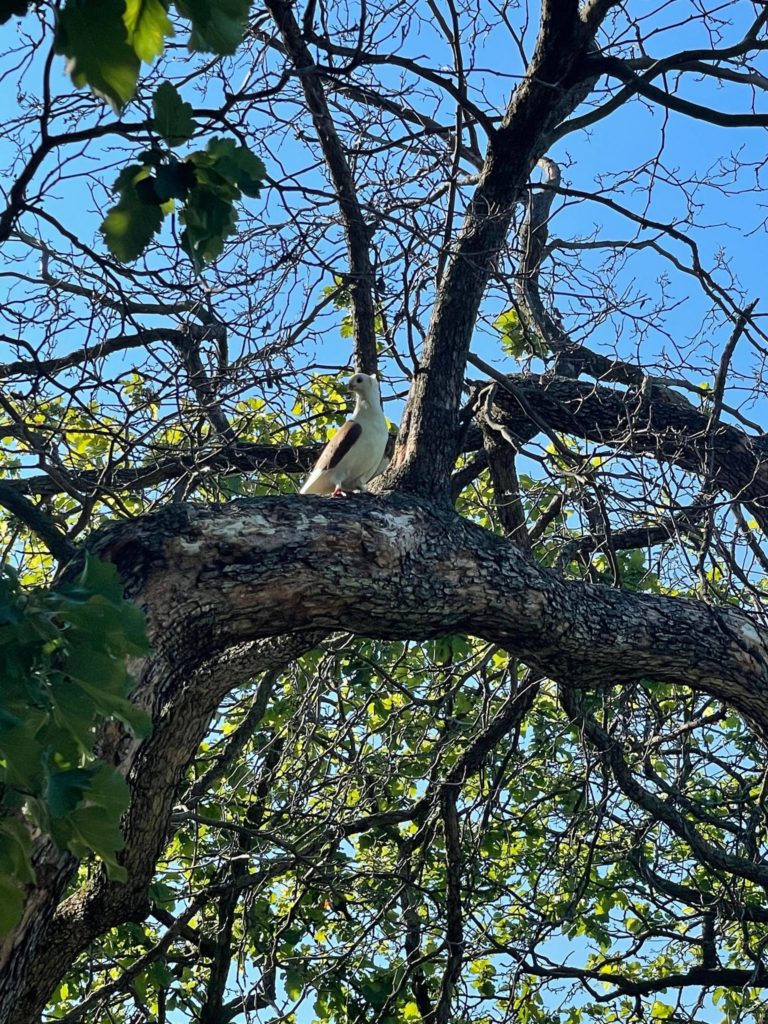

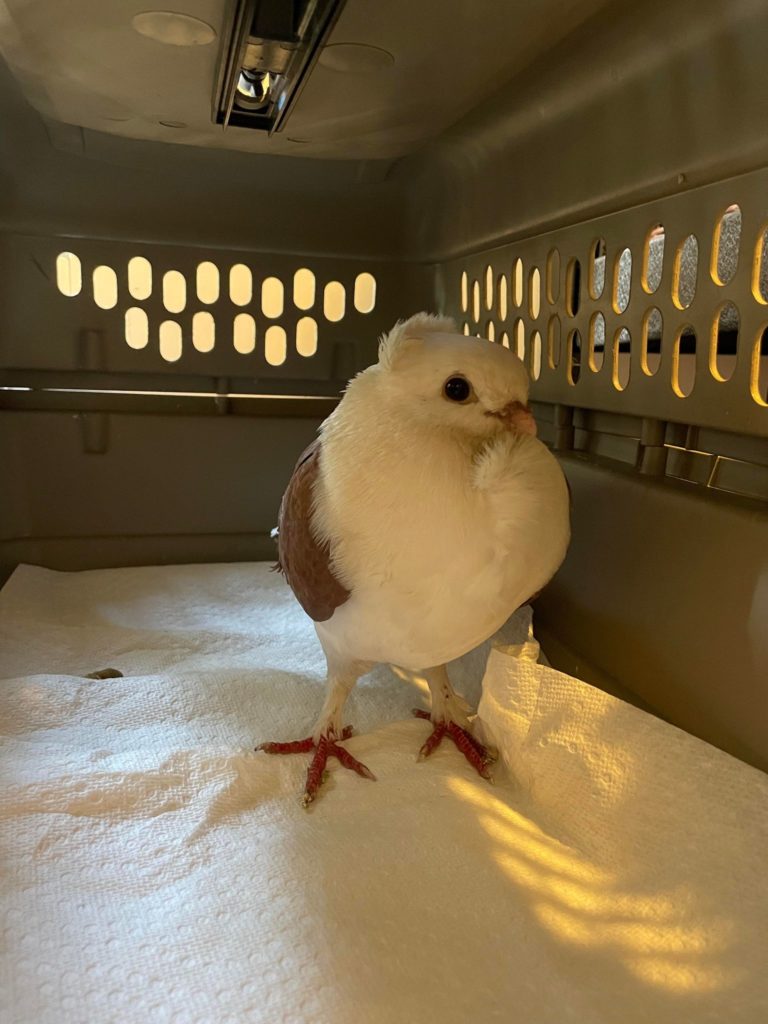
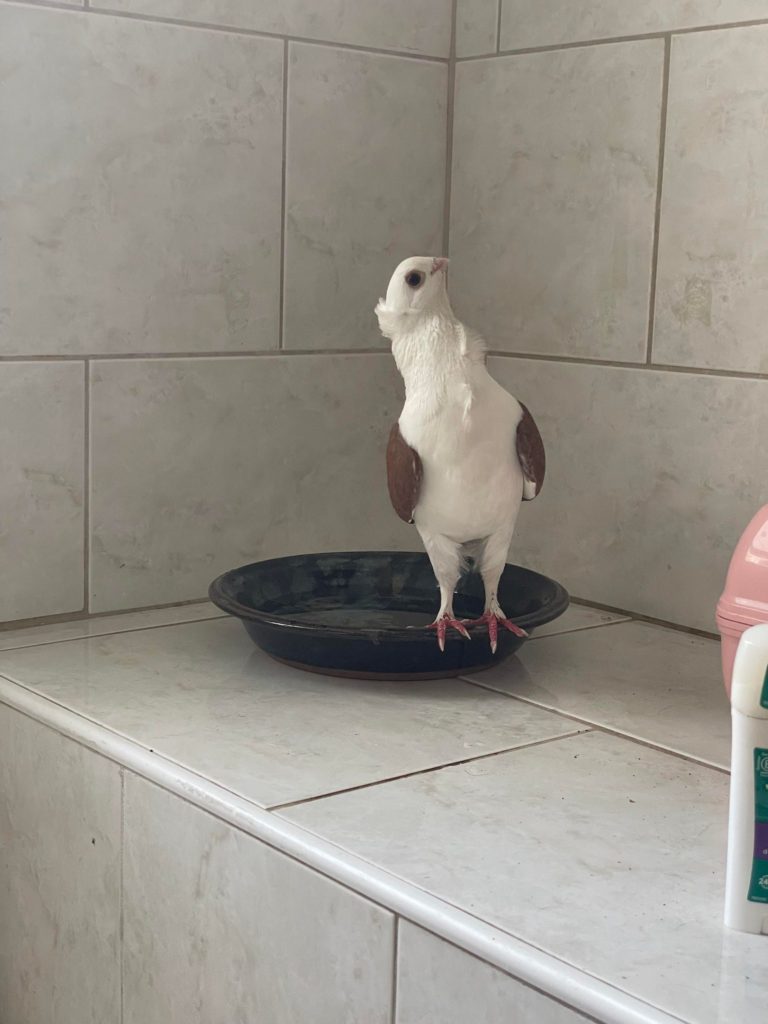

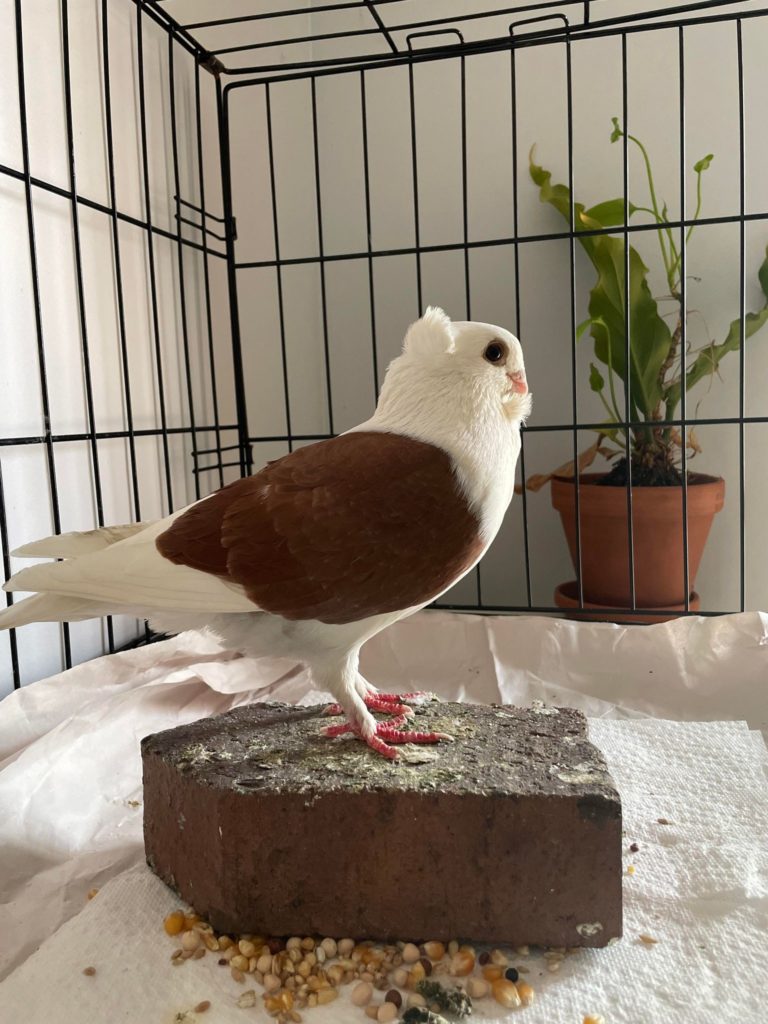
If you spot a pigeon who looks like they don’t quite fit in, chances are that they may need rescue or assistance. They may have been dumped by their keepers who got tired of them, or they may be escapees. Capturing such a bird, assessing them and getting them veterinary assistance can be lifesaving! Please remember, pigeons also are deserving of veterinary care. With care, like many other rescued animals, pigeons can survive and transcend severe trauma and go on to live fulfilling and happy lives.

Conclusion
While pigeons may not be the first species to pop into your mind when it comes to sanctuary, these lovely birds also often need and deserve rescue, human kindness, and sanctuary. As a smaller and quieter species, pigeons can be uniquely suited to microsanctuary care contexts. Even if you as an individual rescuer cannot care for a pigeon yourself, you can educate other humans about pigeon stigma, spend a little effort destringing feral pigeons, or help to bring pigeons in need of assistance to pigeon-friendly rescues. Educating others about pigeons is also a helpful way to support these birds. All of these efforts can go a long way to promote the acceptance of these small feathered friends!
SOURCES:
The Importance Of Language Choices At Your Animal Sanctuary | The Open Sanctuary Project
Language Choices At The Open Sanctuary Project | The Open Sanctuary Project
Estimating Species Lifetime Care Costs At Your Animal Sanctuary | The Open Sanctuary Project
Determining Your Animal Sanctuary’s Capacity For Responsible Care | The Open Sanctuary Project
Chickens: How We Got Here | The Open Sanctuary Project
Columbidae: Doves And Pigeons | Animal Diversity Web
What’s The Difference Between Pigeons And Doves? | Mental Floss
Pigeons and Doves | The Beauty of Birds
How To Speak Pigeon | Popular Science
Rock Pigeon | Audubon Guide To North American Birds
How Do Pigeons’ Feet Get Injured? | Palomacy
Pigeons And Leg Bands | Palomacy
What’s Pigeon Racing | Palomacy
Why Dove Releases Are Cruel | Palomacy
Pigeon And Dove Friendly Rescues In The U.S. | Palomacy
Magnetoreception In Birds | Journal Of The Royal Society Interface (Non-Compassionate Source)
Non-Compassionate Source?
If a source includes the (Non-Compassionate Source) tag, it means that we do not endorse that particular source’s views about animals, even if some of their insights are valuable from a care perspective. See a more detailed explanation here.








